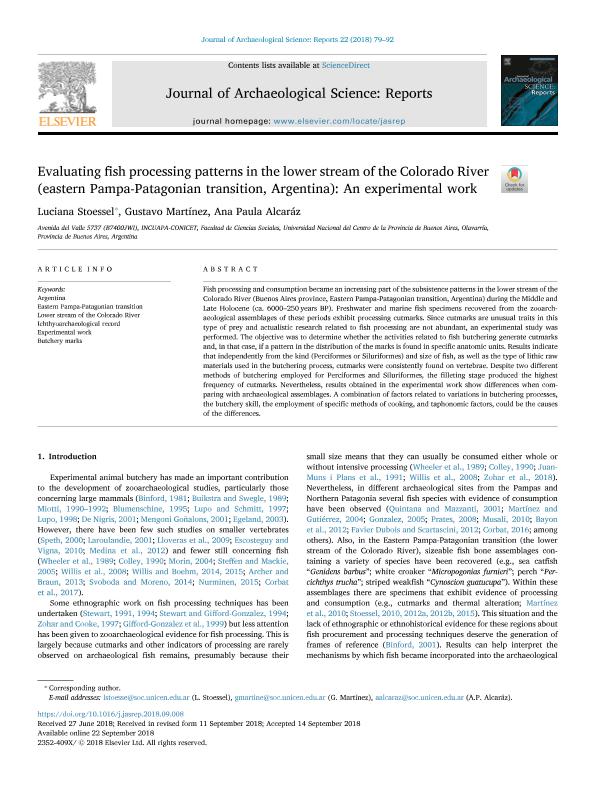Artículo
Evaluating fish processing patterns in the lower stream of the Colorado River (eastern Pampa-Patagonian transition, Argentina): An experimental work
Fecha de publicación:
12/2018
Editorial:
Elsevier
Revista:
Journal of Archaeological Science: Reports
ISSN:
2352-409X
Idioma:
Inglés
Tipo de recurso:
Artículo publicado
Clasificación temática:
Resumen
Fish processing and consumption became an increasing part of the subsistence patterns in the lower stream of the Colorado River (Buenos Aires province, Eastern Pampa-Patagonian transition, Argentina) during the Middle and Late Holocene (ca. 6000–250 years BP). Freshwater and marine fish specimens recovered from the zooarchaeological assemblages of these periods exhibit processing cutmarks. Since cutmarks are unusual traits in this type of prey and actualistic research related to fish processing are not abundant, an experimental study was performed. The objective was to determine whether the activities related to fish butchering generate cutmarks and, in that case, if a pattern in the distribution of the marks is found in specific anatomic units. Results indicate that independently from the kind (Perciformes or Siluriformes) and size of fish, as well as the type of lithic raw materials used in the butchering process, cutmarks were consistently found on vertebrae. Despite two different methods of butchering employed for Perciformes and Siluriformes, the filleting stage produced the highest frequency of cutmarks. Nevertheless, results obtained in the experimental work show differences when comparing with archaeological assemblages. A combination of factors related to variations in butchering processes, the butchery skill, the employment of specific methods of cooking, and taphonomic factors, could be the causes of the differences.
Archivos asociados
Licencia
Identificadores
Colecciones
Articulos(INCUAPA)
Articulos de INVESTIGACIONES ARQUEOLOGICAS Y PALEONTOLOGICAS DEL CUATERNARIO PAMPEANO
Articulos de INVESTIGACIONES ARQUEOLOGICAS Y PALEONTOLOGICAS DEL CUATERNARIO PAMPEANO
Citación
Stoessel, Luciana; Martinez, Gustavo Adolfo; Alcaraz, Ana Paula; Evaluating fish processing patterns in the lower stream of the Colorado River (eastern Pampa-Patagonian transition, Argentina): An experimental work; Elsevier; Journal of Archaeological Science: Reports; 22; 12-2018; 79-92
Compartir
Altmétricas




